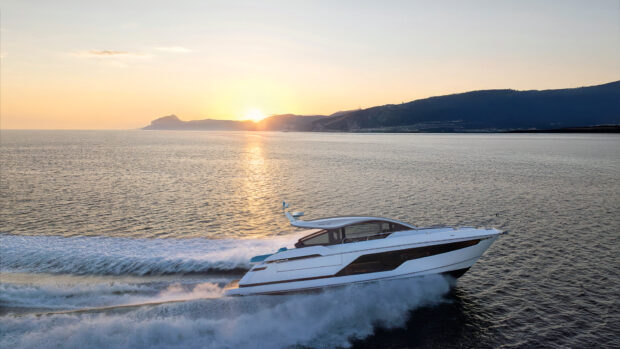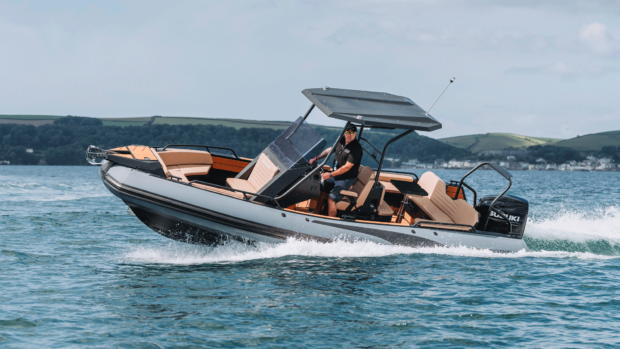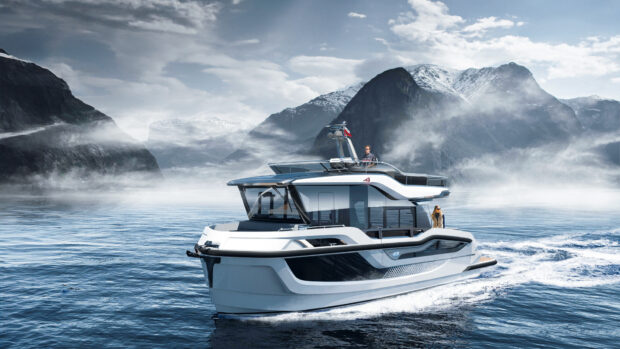Crew: Kim Hollamby, Piers du Pre & Howard Jones.
From: Sharpness Marina, Gloucestershire.
To: Gloucester Dock, Gloucestershire.
Port engine start hours: 319.5. Finish hours: 321.7. Hours run: 2.2.
Stbd engine start hours: 318.1. Finish hours: 320.1. Hours run: 2.0.
Log start: 3443.5nm. Log finish: 3457.1. Distance run: 13.6.
Navigation log (full commentary follows below)
0955: depart marina.
1012: Purton Lower Bridge.
1051: Cambridge Arm.
1123: arrive Fretherne and moor on bank upstream of bridge.
1353: depart Fretherne.
1420: KH drop off onto bank at Pegthorne for photographs. Then back onboard.
1450: Hardwicke.
1539: Monks Meadow.
1551: Gloucester. Moored on concrete lighter next to the National Waterways Museum.
Commentary
An easier day was in prospect and to be frank it felt like one was due, having spent quite a few days now covering a lot of mileage in more ways than one. There’s nothing like a placid inland waterway to smooth off any ragged edges and so all aboard Missing Link were of a frame of mind to appreciate the Gloucester-Sharpness Canal, especially as we only saw about three boats moving all day.
Originally designed to bypass the Severn Estuary, which dries to a mere trickle at low water, the canal was completed in 1827 and was still catering for ships as large as 5000-tonnes until recent times. However, its main trade these days is in the movement of craft carrying cargoes of leisure-seekers.
As we left Sharpness, the immediate view from the grandstand perch afforded by the combined height of Missing Link’s flybridge and the elevation of the canal was of the Severn below, its alleyways of rapidly ebbing water zig-zagging between sandbars and mudflats.
Soon afterwards we passed through the lonely pillars of a railway bridge that met its demise in the 1950s. A petrol tanker was so intent on racing its partner to the lock, that it missed Sharpness in the fog and found out just how loud a bang its cargo would make when colliding with what was also a convenient means of carrying gas from one shore to the other. Deemed uneconomic to repair, the only visible remains of the bridge these days are stone piers either side of the canal and the barest hint of steel structures below the high water mark.
Although its banks are steel-bordered, the canal is more rural than the first time visitor might expect, straight in parts but not uninteresting, and punctuated at regular intervals by low-lying bridges which swing to let craft through.
All of the mostly hand-wound bridges are manned and we took time out at Fretherne to talk with keeper Ken Hill, better known by all as Dasher. He carries the kind of twinkle in his eye that tells you he has seen it all and knows just a little bit more again in the most unassuming of ways.
Dasher is one of an increasingly exclusive band of part-time fishermen on the Severn Estuary who stand leg-deep on sandbars with nets resembling giant lacrosse sticks. A skill passed down through generations tells him how to spot the tell-tale signs in the opaque fast moving waters that a salmon is trying to take a shortcut across the bank. If one is seen, the idea is to chase forward with the net to cut the fish off at the pass and scoop it up.
Years ago it would not have been uncommon for Dasher to have got up at 3.30am and captured up to eight prime salmon by the time it came to wade back ashore for work. Now he sometimes struggles to catch one. He is not sure why this might be, although he suspects that the salmon stock may be suffering at the hands of the predatory zander, a pointlessly aggressive non-native breed of fish that has established a hold on the upper reaches of the Severn and invaded the canal also.










